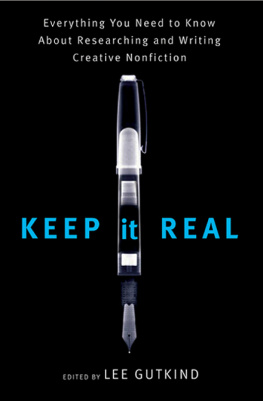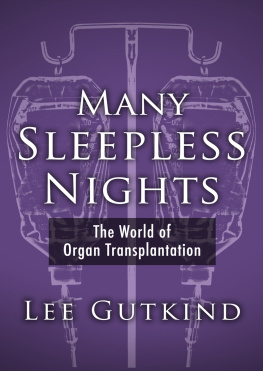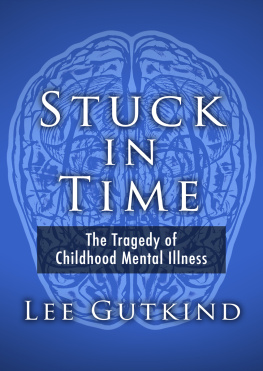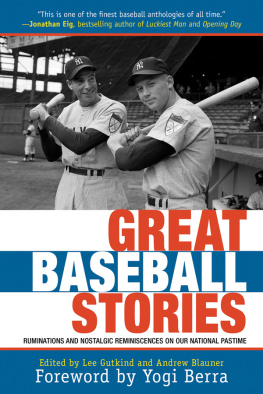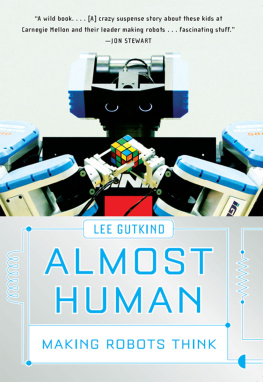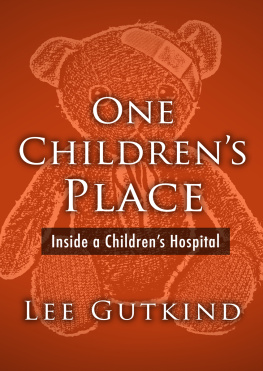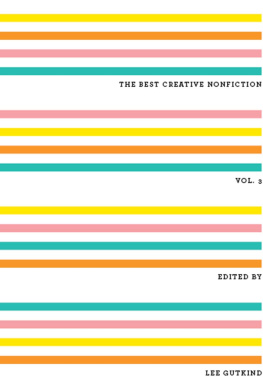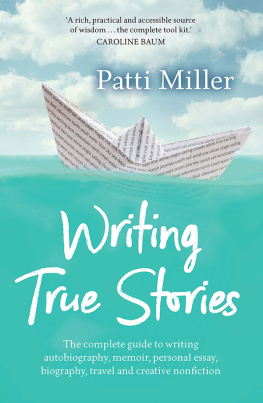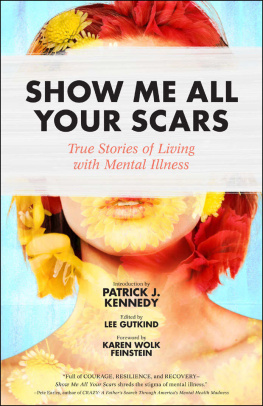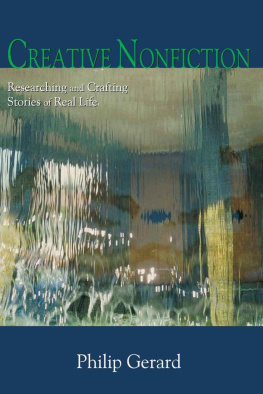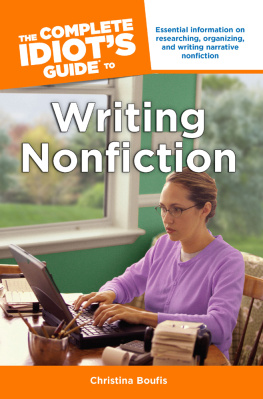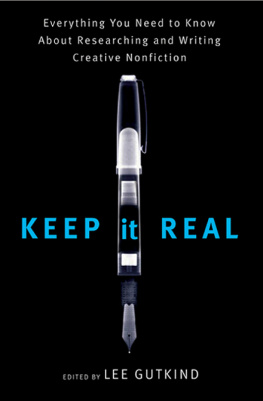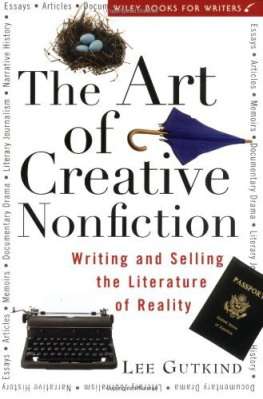
Copyright 2014 Creative Nonfiction Foundation. All rights reserved.
Requests for permission to reproduce material from this work should be sent to:
Rights and Permissions
In Fact Books
c/o Creative Nonfiction Foundation
5501 Walnut Street, suite 202
Pittsburgh, PA 15232
Cover and text design by Tristen Jackman
ISBN: 978-1-9371631-7-4
To Lea Simonds,
whose consistent support and friendship have kept Creative Nonfiction goingand growingfor 20 years.
CONTENTS
Susan Orlean
F irst of all, dont worry about what its called. Call it narrative nonfiction, or literary journalism, or creative nonfiction, or long-form narrative, or feature writing. Does it matter? How about: I just learned something really fascinating and now Im going to tell you about it. Or how about: I am going to write this so vividly that you will feel you are experiencing the story with me. And: Everything in this is true. And: Life is just so damn interesting.
Like pornography, you dont need a definition, anyway, because you will know it when you read it. I did, right from the start. My first encounter with creative nonfiction came when I was a kid. At the time, I was pawing through a copy of Life magazine, which was my favorite periodical back then, mostly because it always featured cute pictures of baby animals. I dont remember the year or month. I do remember sitting on the floor of our living room, flipping through the pages of the new issue, and coming across a story that described a day in the life of a small-town doctor, a general practitioner in Minnesota or Kansas or someplace like that. As much as the pictures of baby animals in the back of the magazine beckoned me, I lingered on that story. I can still recall one photograph of the doctor, exhausted and rumpled after a long day of delivering babies, bandaging skinned knees, and telling a few people some bad news about their health. In my minds eye, I picture him slumped against a cabinet of medical supplies. He might have been smoking a cigarette.
There was no obvious reason for the story to have been writtenthat is, there was nothing extraordinary about this doctor or this town, no significance to the particular day that was examined. The story simply detailed the ebb and flow of the day and the dozens of little dramas that the doctor encountered, and it implied, without saying it in so many words, how important the doctor was to his community, and how the stories of all the lives of the town could be seen in cross-section by observing his world. The story also implied, by the mere fact of its existence, that it was important to know something about other people, whoever they were, and not only when something newsworthyin the conventional sensehad happened to them.
I was really young at the time, but even so, I was fascinated by the story. I remember thinking, you can really write stories about things like this, just stories about life? And then I thought, I want to do that! I really did. I never wanted to be a ballerina or a movie star or any of those other fantasy careers little girls often have. I wanted to be a writer, and as soon as I saw that story, I dreamed about being able to write stories like itstories that seemed like they didnt need to be told. That meant, of course, that they urgently needed to be told, because learning something new about the world or about someone, and then telling it to other people, is essential, crucial, transformational, and therefore urgent.
And now comes the hard part. If you cant really define what this isthis hard-to-name, difficult-to-define practice of telling true storieshow are you supposed to learn how to do it? How do you do it right? Since it doesnt have the rules of typical journalismno inverted pyramid of information, for instancehow do you know what makes it work? Theres no simple answer, since its not a simple form. The best piece of advice I ever got was from my first editor, who explained to me that writing nonfiction of this sort was a three-part process. First, you report, he said, and then you think, and only then do you begin to write. I knew about the reporting and the writing parts, but the thinking part was a surprise. Im not sure I understood what he meant at the time, but as I dug into bigger stories and more challenging narratives, I started to appreciate what he meant. Gathering information is where you start, and disseminating it is where you end, but if you dont spend the time in the middle processing what youve learned, putting it in context, questioning why you cared about it, and assessing how learning it has changed you, you cant write a great story. This means you should spend a lot of time as a writer looking like youre not working because thinking doesnt really look like much to an outsider. (The closets of writers around the world get extremely well organized during that thinking phase, because we feel like were not being productive since were not reporting and were not yet writing, so we panic and we organize our closets.) That thinking part is so important and so easy to shortchange. In fact, if I could do anything differently with stories Ive written, it would be to have given myself a little more time to think about them before I wrote a single word.
Other wisdom Ive collected over the years: Dont over-prepare. Be willing to jump into stories naked; youll listen harder and learn more authentically. On the other hand, do over-report. Follow bits of the story that arent quite on topic; youll probably find something unexpected and fascinating. Dont obsess about your notes. Take good ones, and make them accurate, but most of what you learn is taken in and recorded in your brain (or should be), and your notes really are just there as prompts. Also: read and read and read and read. Keep your favorite pieces of writing on your desk and imitate them. I dont mean steal from them; I mean use them as models, the way you might model your golf swing on a video of Tiger Woods. Write what you want to learn. Then learn it well enough to teach it, which is really what writing is. Choosing your own stories is a luxury that not every writer has, and often you will find yourself assigned to write about something you honestly dont care about and it seems impossible to pretend you want to learn about it. In that case, think of it as a writing exercise in which you will practice the art of inquisitiveness. Also, is there really nothing at all in the subject you wonder about? If so, question your choice of careers, since I cant think of a quality more essential for a writer than curiosity. Make beautiful sentences, but dont worry about making them fancy. Read everything out loud, either to yourself or to a willing listener. Cut out the boring parts. Put in a few jokes. Do not fear the editors pencil; almost every story gets better when its tightened up. Anyway, its better to leave readers wishing your story kept going than to have them bail out halfway through because it got too long. This list could go on and on. Every story is so different; every interview, even, is so different, that there cant beand shouldnt bean instruction manual for how to do it. Thats what makes it such a maddeningly addictive profession: its new all the time. Thats also why its hard. Thats also why its wonderful.
I suppose sometime I should look up that Life
Next page

